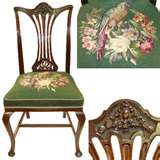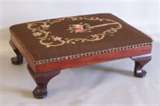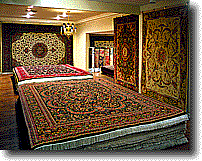From time to time we are asked to clean upholstery, usually chairs, that were covered with handmade needlepoint fabric woven by a family member. Usually the conversation starts with our client saying: “Can you safely clean this upholstery without changing the coloring, texture or creating dye bleeding?”. Usually our answer is: Yes, with restrictions. These needlepoints are usually more than 40 years old and have never been cleaned. Dye degradation can exist, possibly resulting in rapid and irreversible dye bleeding. Some other concerns include:
- Weakened fabric-cleaning, even gentle cleaning, can result in tears in fabric that is old and has been subjected to UV light and heavy wear
- Natural stuffing material-the cloth under the needlepoint, usually jute, possibly with horsehair, can bleed through to the top and create watermarking and browning.
- Wood finishes-the shellac or lacquer finishes contain dyes and after many years these dyes can rub off the wood and be washed onto the fabric creating a permanent stain.
- Metal buttons and tacks-water based cleaning solutions may react with steel and iron buttons or tacks and can create rust marks on the needlepoint fabric. Rust at times is permanent.
Here’s what we suggest:
- Clean the piece before it shows signs of soiling. Light soil removal is less risky for delicate fabric and fibers
- Solvent (dry) cleaning-Solvent cleaning may be applicable in this situation. Solvents usually don’t create rust or dye bleeding. Even with solvent cleaning successful cleaning is not guaranteed.
- Remove the fabric for cleaning-have a skilled upholsterer remove the needlepoint fabric-your cleaner then tacks out the fabric flat on plywood using stainless steel tacks and cleans, allowing the fabric to remain tacked out for 24 hours. The upholsterer replaces the needlepoint to the chair after re-stuffing the seat with new synthetic cushion (not foam).
Here’s what we suggest:
- Clean the piece before it shows signs of soiling. Light soil removal is less risky for delicate fabric and fibers
- Solvent (dry) cleaning-Solvent cleaning may be applicable in this situation. Solvents usually don’t create rust or dye bleeding. Even with solvent cleaning successful cleaning is not guaranteed.
- Remove the fabric for cleaning-have a skilled upholsterer remove the needlepoint fabric-your cleaner then tacks out the fabric flat on plywood using stainless steel tacks and cleans, allowing the fabric to remain tacked out for 24 hours. The upholsterer replaces the needlepoint to the chair after re-stuffing the seat with new synthetic cushion (not foam).
No matter the plan of action you chose make sure the cleaner tests the dye for stability and the foundation yarns for rippling in a small area of the seat prior to complete cleaning.
Questions? david.mavilio@regalclean.com





{ 2 comments… read them below or add one }
Hello
We have several videos that may help if you plan on doing it yourself.
You can find them here
https://www.youtube.com/playlist?list=PLW9Wkm5mJBKksKsjZc1-qZxcrWBDqXI06
also here
https://www.youtube.com/playlist?list=PL5240BE9400645680
My suggestion is to reach out to a professional in your area for guidance.
Good luck!!
I have a wooden chair that has a needlepoint floral design that I would like to take off and clean it was my grandmothers, and she had it before I was born in1965. I have removed the seat from the chair, but the needlepoint is on an old canvas piece and is tacked to the bottom of the chair with tiny nails/tacks. I am guessing there is cotton batting for the seat part under the needlepoint. It has never been cleaned to my knowledge except for being vacated. There is a darker stain, on the white/beige part of it that looks like some kind of spill. Not sure of the best way to clean this.
Thank You
MaryKay D’Avello
marykaydavello@hotmail.com